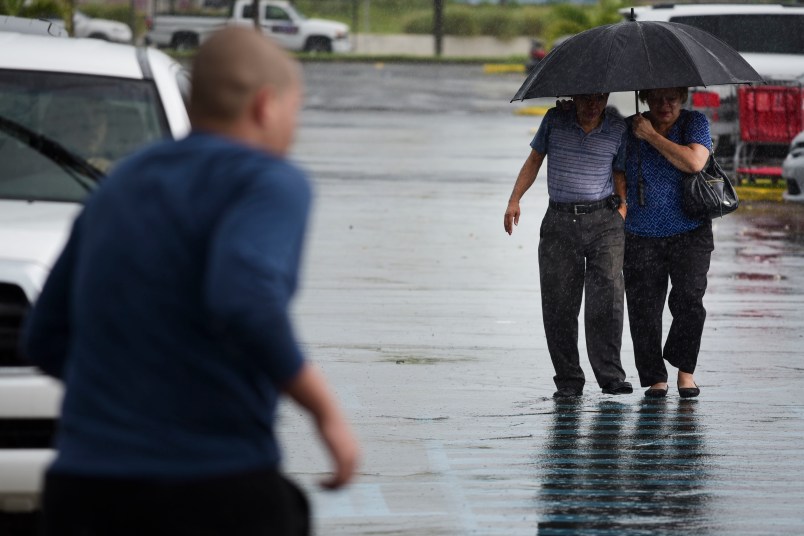ST. JOHN’S, Antigua (AP) — The most powerful Atlantic Ocean hurricane in recorded history made its first landfall in the islands of the northeast Caribbean early Wednesday, roaring along a path pointing to Puerto Rico, the Dominican Republic, Haiti and Cuba before possibly heading for Florida over the weekend.
The eye of Hurricane Irma passed over Barbuda around 1:47 a.m., the U.S. National Weather Service said. Residents said over local radio that phone lines went down. Heavy rain and howling winds raked the neighboring island of Antigua, sending debris flying as people huddled in their homes or government shelters.
Officials warned people to seek protection from Irma’s “onslaught” in a statement that closed with: “May God protect us all.”
In Barbuda, the storm ripped the roof off the island’s police station forcing officers to seek refuge in the nearby fire station and at the community center that served as an official shelter. The Category 5 storm also knocked out communication between islands. Midcie Francis of the National Office of Disaster Services confirmed there was damage to several homes, but said it was too early to assess the extent of damage.
The storm had maximum sustained winds of 185 mph (295 kph), according to the Hurricane Center. It said winds would likely fluctuate slightly, but the storm would remain at Category 4 or 5 strength for the next day or two. The most dangerous winds, usually nearest to the eye, were forecast to pass near the northern Virgin Islands and near or just north of Puerto Rico on Wednesday.
“I hear it’s a Cat 5 now and I’m terrified,” Antigua resident Carol Joseph said Tuesday as she finished her last trip to the supermarket before seeking shelter. “I had to come back for more batteries because I don’t know how long the current will be off.”
On the 108-square-mile (280-square-kilometer) island, people who live in low-lying areas were staying with friends and relatives on higher ground or sleeping in churches, schools and community facilities built to withstand hurricanes. None of the shelters had yet been tested by Category 5 winds, however.
Many homes in Antigua and Barbuda are not built on concrete foundations or have poorly constructed wooden roofs.
President Donald Trump declared emergencies in Florida, Puerto Rico and the U.S. Virgin Islands, and authorities in the Bahamas said they would evacuate six southern islands.
Warm water is fuel for hurricanes and Irma was moving over water that was 1.8 degrees (1 degree Celsius) warmer than normal. The 79 degree (26 Celsius) water that hurricanes need went about 250 feet (80 meters) deep, said Jeff Masters, meteorology director of the private forecasting service Weather Underground.
Four other storms have had winds as strong in the overall Atlantic region, but they were in the Caribbean Sea or the Gulf of Mexico, which usually have warmer waters. Hurricane Allen hit 190 mph in 1980, while 2005’s Wilma, 1988’s Gilbert and a 1935 great Florida Keys storm all had 185 mph winds.
The northern Leeward Islands were expected to see normal tide levels rise by as much as 11 feet (3.3 meters), while the Turks and Caicos Islands and southeastern Bahamas could see surge of 20 feet (6 meters) and higher waves later in the week, forecasters said.
Bahamas Prime Minister Hubert Minnis said his government was evacuating six islands in the south because authorities would not be able to help anyone caught in the “potentially catastrophic” wind, flooding and storm surge. People there would be flown to Nassau in what he called the largest storm evacuation in the country’s history.
“The price you may pay for not evacuating is your life or serious physical harm,” Minnis said.
The U.S. National Weather Service said Puerto Rico had not seen a hurricane of Irma’s magnitude since Hurricane San Felipe in 1928, which killed a total of 2,748 people in Guadeloupe, Puerto Rico and Florida.
“The dangerousness of this event is like nothing we’ve ever seen,” Puerto Rico Gov. Ricardo Rossello said. “A lot of infrastructure won’t be able to withstand this kind of force.”
The director of the island’s power company has warned that storm damage could leave some areas without electricity for about a week to as long as six months.
The eye of the storm was expected to rip westward on a path taking it a little north of Puerto Rico, the Dominican Republic, Haiti and Cuba.
The northern parts of the Dominican Republic and Haiti could see 10 inches (25 centimeters) of rain, with as much as 20 inches (50 centimeters) in the southeast Bahamas and Turks and Caicos.
The storm seemed almost certain to hit the United States by early next week.
“You’d be hard pressed to find any model that doesn’t have some impact on Florida.” said University of Miami senior hurricane researcher Brian McNoldy.
In Florida, people stocked up on drinking water and other supplies.
Florida Gov. Rick Scott activated 100 members of the Florida National Guard to be deployed across the state, and 7,000 National Guard members were to report for duty Friday when the storm could be approaching the area. On Monday, Scott declared a state of emergency in all of Florida’s 67 counties.
Officials in the Florida Keys geared up to get tourists and residents out of Irma’s path, and the mayor of Miami-Dade County said people should be prepared to evacuate Miami Beach and most coastal areas.
Mayor Carlos Gimenez said the voluntary evacuations could begin as soon as Wednesday evening. He activated the emergency operation center and urged residents to have three days’ worth of food and water.
The Hurricane Center in Miami said hurricane-force winds extended 50 miles (85 kilometers) from Irma’s center and tropical storm-force winds extended 175 miles (280 kilometers).
Also Wednesday morning, a new tropical storm formed in the Gulf of Mexico off Mexico’s coast. Tropical Storm Katia had maximum sustained winds of 40 mph (65 kph) with some strengthening forecast over the next two days. But the hurricane center said Katia was expected to stay offshore through Friday morning.
And another tropical storm farther east in the Atlantic was expected to become a hurricane by Wednesday night. Tropical Storm Jose’s maximum sustained winds had increased to near 60 mph (95 kph). The storm was centered about 1,255 miles (2,020 kilometers) east of the Lesser Antilles and was moving west near 13 mph (20 kph).
___
Coto reported from San Juan, Puerto Rico. Associated Press writers Seth Borenstein in Washington, Michael Weissenstein in Havana, Cuba, and Ben Fox in Miami contributed to this report.







As of this morning it like like mega bitch Irma plans on a road trip right up the middle of the Florida peninsula. If that happens it will make Katrina and Harvey look like lawn sprinklers. I really love living in Florida but this shit works on that. If you haven’t been in a hurricane let me tell you…they really suck. Try, if you can, not to make jokes about this one hitting Mar a Lago or Rush Limbaugh’s pad. Lots of people are alive today that will not be in a week. Lets keep this real.
Not to mention the actual American citizens in Puerto Rico, which is already struggling to just keep the lights on, thanks to the Wall Street owned Congress forcing impossible financial conditions on them.
This is interesting in light of people wanting to send donations for Harvey and soon Irma. Have no idea how true it is, but I can believe it might be somewhat.

The NOAA-NHC projected 5-day path is admittedly a best guess and can easily change as time passes.
Nonetheless, it’s downright disheartening to see the current mainland US landfall point is around Homestead, FL. The 25th anniversary of Hurricane Andrew’s landfall was just last month. It was category 5, too.
Stay safe!